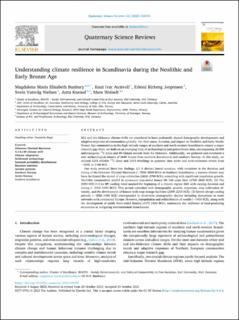| dc.contributor.author | Bunbury, Magdalena Maria Elisabeth | |
| dc.contributor.author | Austvoll, Knut Ivar | |
| dc.contributor.author | Jørgensen, Erlend Kirkeng | |
| dc.contributor.author | Nielsen, Svein Vatsvåg | |
| dc.contributor.author | Kneisel, Jutta | |
| dc.contributor.author | Weinelt, Mara | |
| dc.date.accessioned | 2024-03-19T11:38:49Z | |
| dc.date.available | 2024-03-19T11:38:49Z | |
| dc.date.created | 2023-11-18T20:37:03Z | |
| dc.date.issued | 2023 | |
| dc.identifier.issn | 0277-3791 | |
| dc.identifier.uri | https://hdl.handle.net/11250/3123093 | |
| dc.description.abstract | Mid and late-Holocene climate shifts are considered to have profoundly shaped demographic developments and adaptive responses of communities globally. Yet their onset, duration, and impact on Neolithic and Early Nordic Bronze Age communities in the high-latitude ranges of southern and north-western Scandinavia remain a major research gap. Here, we built on an emerging body of archaeological and paleoclimate data, encompassing 20,908 anthropogenic 14C dates and 49 climate records from the Holocene. Additionally, we gathered and correlated a new archaeological dataset of 3649 houses from southern Scandinavia and southern Norway. In this study, we utilised 6268 reliable 14C dates and 2519 dwellings to generate time series and socio-economic trends from ∼4100 to 1100 BCE. Our study revealed three key findings: (1) A distinct lateral zonation, with variations in the duration and timing of the Holocene Thermal Maximum (∼7050–2050 BCE). In Southern Scandinavia, a warmer climate may have facilitated the spread of crop cultivation (3820–3790 BCE), coinciding with significant population growth. Neolithic communities settled in permanent two-aisled houses 90–160 years later (3700–3660 BCE). (2) The 2250 BCE (4.2 ka BP) cooling trend marked the beginning of a climate regime shift with varying duration and timing (∼3450–1450 BCE). This period coincided with demographic growth, migration, crop cultivation diversity, and the development of houses with crop storage facilities (2290–2215 BCE). (3) Severe abrupt cooling periods (∼1850–1450 BCE) corresponded to short-term demographic decline including disruptions in trade networks with continental Europe. However, repopulation and redistribution of wealth (∼1450 BCE), along with the development of stable three-aisled houses (1475–1450 BCE), underscore the resilience of food-producing economies in mitigating environmental disturbances. | en_US |
| dc.description.abstract | Understanding climate resilience in Scandinavia during the Neolithic and Early Bronze Age | en_US |
| dc.language.iso | eng | en_US |
| dc.title | Understanding climate resilience in Scandinavia during the Neolithic and Early Bronze Age | en_US |
| dc.title.alternative | Understanding climate resilience in Scandinavia during the Neolithic and Early Bronze Age | en_US |
| dc.type | Peer reviewed | en_US |
| dc.type | Journal article | en_US |
| dc.description.version | publishedVersion | en_US |
| dc.source.volume | 322 | en_US |
| dc.source.journal | Quaternary Science Reviews | en_US |
| dc.identifier.doi | 10.1016/j.quascirev.2023.108391 | |
| dc.identifier.cristin | 2198427 | |
| dc.relation.project | Riksbankens jubileumsfond (RJ): M21-0018 | en_US |
| dc.relation.project | Vetenskapsrådet: 2020-01097_VR | en_US |
| cristin.ispublished | true | |
| cristin.fulltext | original | |
| cristin.qualitycode | 2 | |
